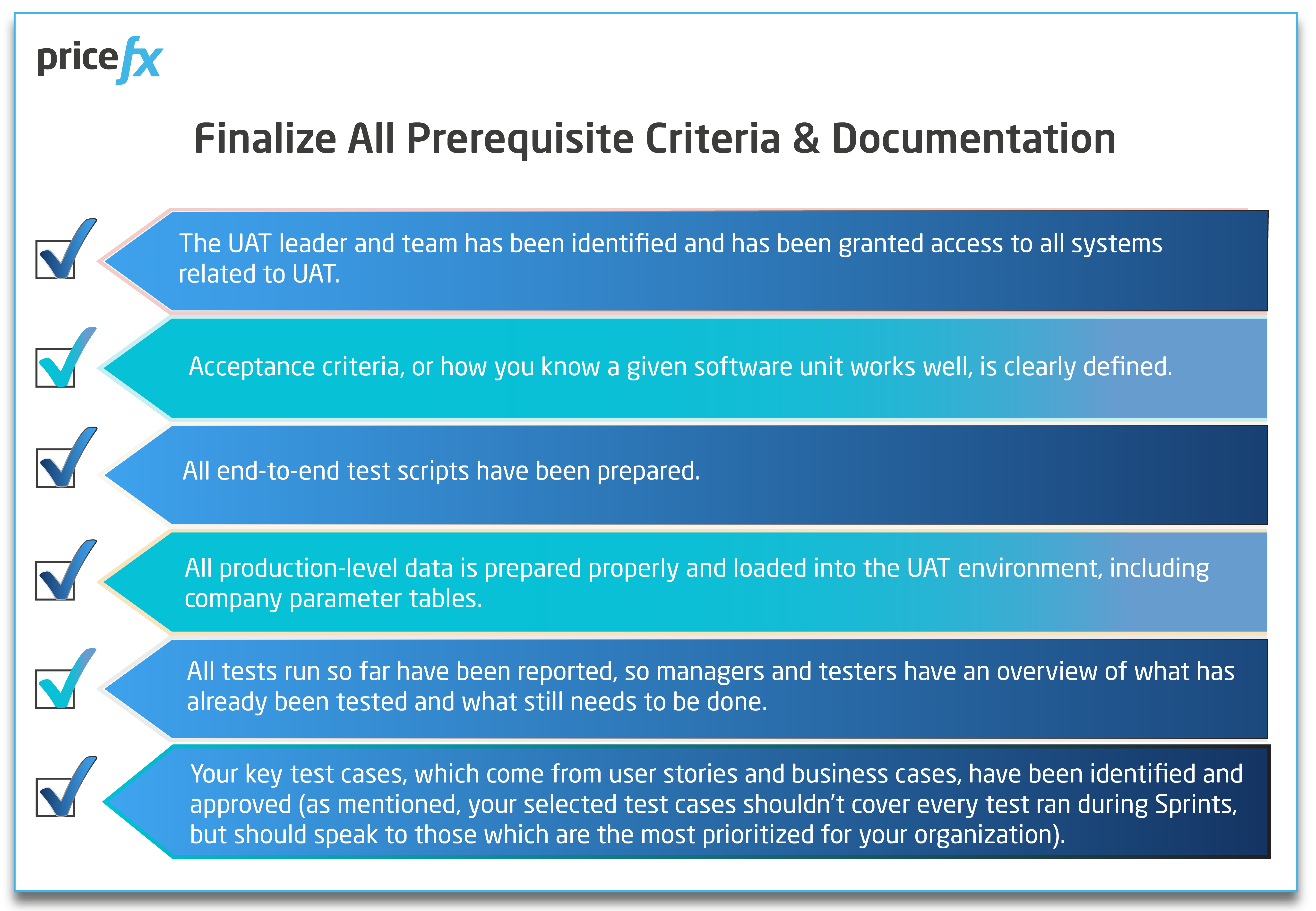User Acceptance Testing: it’s the last step in your software project before go-live, and based on how happy your end users are with the results, will predict how well the tool works for your business and how quickly it gets off the ground.
If UAT sounds important to get right, that’s because it is. While sometimes overlooked as a time-consuming, even unnecessary, part of the project life cycle, it serves an essential function: making sure the software’s core functionalities work how they’re supposed to in the real world so that you get what you pay for.
Here at Pricefx, with over 10 years’ experience helping businesses address their most pressing pricing problems with cloud-native pricing software, we’ve seen that often, our customers experience issues in UAT which can be easily addressed by understanding what UAT is really for (and not for) and how to best prepare for it.
In this article, you’ll learn what UAT actually is, how it’s used, and the key ways organizations should prepare to get the most of the UAT stage.
What is User Acceptance Testing and How is it Used?
UAT is the final step in the project life cycle before it goes live. You can think of it like the final school-leaving exam after a series of smaller unit tests that have prepared you for this moment.
Just like a school-leaving exam, it’s all-or-nothing with UAT – if the solution doesn’t “pass,” or isn’t ready for acceptance, the company won’t be able to move forward and use the tool in the real world. Participants at the UAT stage need to know their stuff – this includes knowing their way around the tool and the cases they want to prioritize for testing.
“Acceptance” in UAT is the moment a tester group decides a unit of software is ready for production, or go-live. The acceptance criteria (AC), or the conditions that need to be met in order to be accepted, are unique to the customer and the user stories they are working with.
What is UAT used for?
UAT has specific goals in mind that should be well understood so your organization can better gauge whether it’s ready to move onto this stage. These include:
- End-to-end testing of the software in a real environment (your pricing software integrated with your CRM, ERP, and any other systems used for pricing)
- Checking how well the software does what it needs to do to support your business
- Acceptance of the software to continue on to go-live
What is UAT not used for?
It is just as crucial to recognize the action items which UAT is not meant for, which include:
- Getting to know the software for the first time
- Repeating all unit tests done during Sprints
- Submitting change requests
- Fixing configuration bugs that should have been found during Sprints (note: if you’re seeing multiple errors in UAT, you might not be ready for this phase)
If you find that your test group is focusing the majority of their energy on any of the above, it is likely time to scale back to earlier stages of quality assurance.
Who is involved in UAT?
When assigning those who will take part in UAT, your business should consider the individuals who will be using the platform most in a day-to-day capacity: its business users. While not as technically oriented as the technical users involved in earlier development stages, ultimately those subject matter experts will know best how to use the tool to draw out the most value for the business.
As business users are likely to not have interacted with the software prior to UAT, they should be sufficiently trained and briefed beforehand on the scope of the project; namely, armed with knowledge of the platform and the prioritized cases for testing. Additionally, your business should identify a UAT leader who will act as their first point of contact for any questions or requests for help with the application, as well as report on the overall progress of UAT.
Why is User Acceptance Testing Important?
As the name suggests, UAT is important because it’s the final indication that the software will be positively accepted by its end-users. In other words, this is when the software’s functionality and the end user’s thought processes behind the tool come together in happy matrimony.
Above all, UAT is a standard part of any software project. Unless your business is prepared to take the risk of not securing their planned return on investment, there is no way around UAT to use the tool successfully and in line with their business goals. Because in essence, UAT is the last chance for your company to test and sign off on, or accept, the software’s core functions.
UAT ensures that the actual environment where the software lives is prepared for go-live. While in earlier development stages your business is testing a range of functionalities by themselves, UAT is when you gauge how well the most important end-to-end functionalities work in collaboration with your own CRM and other business systems specific to your customer data. This includes addressing any data issues arising from the integration of these platforms. That said, if your business is frequently coming across different kinds of bugs, this is a sign to pause UAT and focus on ironing those out before proceeding.
In a broad sense, UAT is how its end users verify that the tool is working well in the ways it needs to for their business. And if you think about it, you wouldn’t buy a car before driving and testing the features that matter most to you, would you? UAT offers the same opportunity to the end users who will be in the driver’s seat most – and it’s important to know what to look for.
How to prepare for UAT
We’ve seen a few key places where our customers tend to falter in their preparedness for a successful UAT stage. By dedicating time and resources to each of the below steps, businesses can avoid the costly delays that result from carrying out UAT without a clear plan in place:
1.Select a test management tool
With so many moving parts, UAT can be a messy business, and it’s easy to lose track of the progress made during this phase. To plan, manage, and log tests in one place, you’ll need a test management tool, like Xray, a test management plug-in for Jira. Keep in mind that Excel is not a test management tool.
2. Complete training and other preparation measures
In preparation for testing end-to-end in a real environment, your company should take part in System Integration testing to make sure that your pricing software and internal systems merge in the way they’re supposed to and fix any bugs where possible. UAT testers should also be adequately trained in UAT prior to testing to avoid any delays or misunderstandings around the tool. The Pricefx UAT training module is a great opportunity to prepare your users for end-to-end UAT testing:
3. Finalize all prerequisite criteria and documentation
Prior to UAT start, your team should have prepared and nailed down the following:

4. Align the UAT timeline with your project scope
Your business should have a plan in place that allows its UAT testers enough time to dedicate to testing outside of their standard tasks. While allotting 2 weeks for UAT is a good rule of thumb, projects with more complex requirements may take as long as 6 weeks. Even simpler projects will require a highly coordinated, organized approach on the part of the organization to meet a 2-week UAT time frame (keep in mind that this will require 2-3 hours of daily testing at a minimum).
Getting started with UAT: Key takeaways
Ultimately, it’s crucial that your company takes ownership of its UAT process. By accurately planning the project scope, identifying key individuals involved, and setting up a timeline that covers all necessary actions, your company will be well positioned to use the tool without major errors or delays.
While UAT can be a frustrating and time-consuming process, it can be carried out effectively within the allotted scope, budget, and timelines if your organization is adequately trained and has a clear picture of what needs to get done at this stage.
Curious to see where UAT sits in the software project life cycle? Consider checking out our article below:

